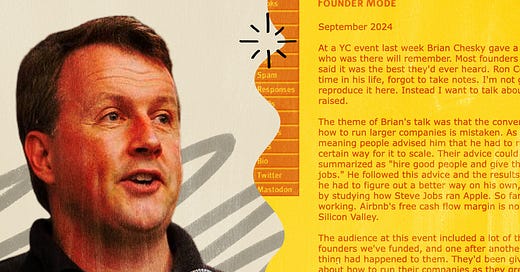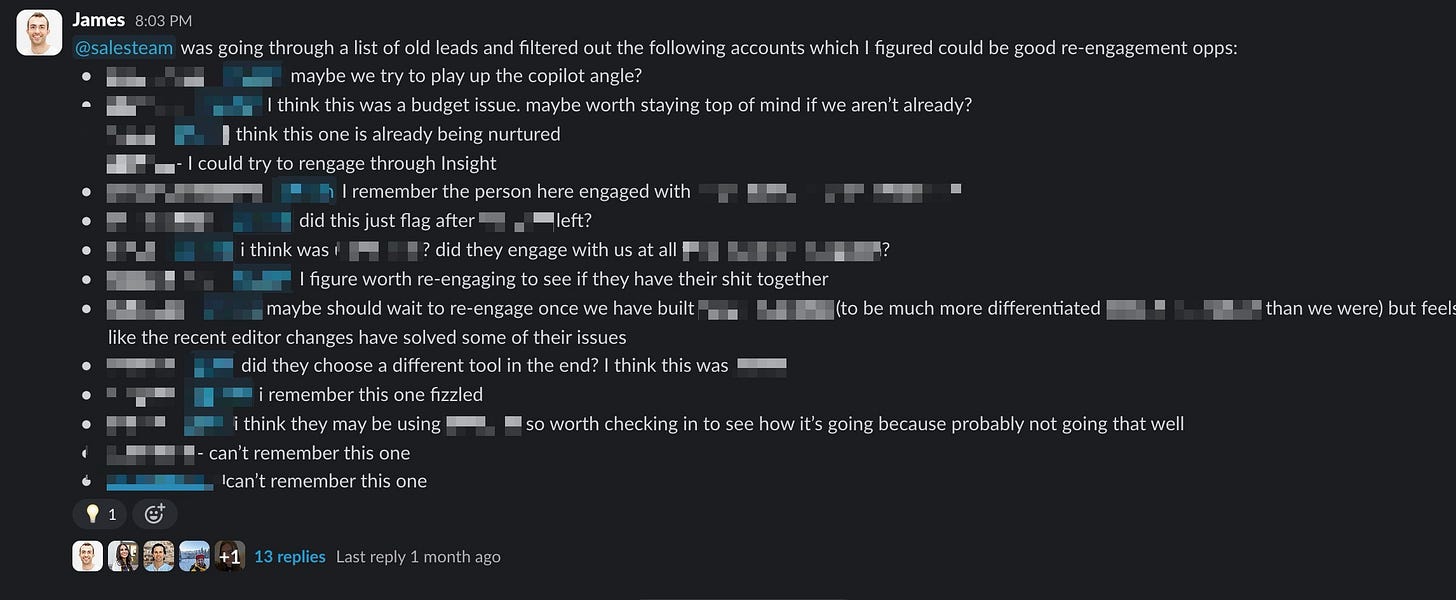If you’re a founder of a <200 person company and the founder mode essay substantially changed your behavior, you’re probably not a good founder. Or you’ve at least drifted from the path.
It sounds harsh, but most good founders I know already operated in founder mode. The essay put something into words that we all knew (even if we couldn’t articulate it). If you needed an essay to tell you to get into founder mode, then founder mode definitely isn’t your default way of operating.
And that’s okay. So many management books tell founders to “decentralize leadership” and “get out of their way”, which I guess is nice at a corporation.
But the core advantage of startups is being opinionated and making radical decisions quickly. If the founder doesn’t embody that, nobody else will — which means giving up your biggest advantage and letting the incumbent win.
But it’s also impossible to always be in founder mode on everything: Limited time, energy and attention mean that the more your company grows, the less time you have for each part. You need to be in manager mode for some parts of the company.
I think about it in terms of altitudes.
5k ft (founder mode) vs. 20k ft (manager mode)
I work on parts of the company in two modes:
5,000 ft: I’m in the loop, know all the details, review everyone’s work and contribute IC work.
20,000 ft: other people are empowered to do the job, I check in regularly and monitor metrics.
If I’m in founder mode on sales, I’ll join calls, listen to recordings when I couldn’t join, help craft responses in Slack, know where most deals are at etc. If I were to enter manager mode, I might check the CRM once a week and expect our GTM lead Joe to flag problems.
That’s not a one-way-door. You should always be in founder mode where your time is most valuable — the biggest opportunities or the problem areas. You can always return to 20,000 ft once the problem is solved or something else becomes more important.
But switching back and forth can confuse (or even infuriate) the team.
How to enter founder mode without pissing off team members
You might not want to swoop in on someone’s work after you’ve been hands-off. After all, it’s annoying for someone to suddenly have to change how they do things.
But if you’re getting closer to a part of the company, that’s for one of two reasons:
That part of the company is a big opportunity. That adds things to the team’s plate, in which case they could use a hand.
That part of the company is a problem area. This means something needs to change, which is why you’re there.
Both cases mean there will be a change in how that team works and your relationship with them. I’m still surprised with how many founders are afraid of doing this. Because I’ve discovered a simple hack that nobody seems to talk about: Tell them what you’re doing!
If you communicate that you’re at 5k ft (founder mode), they know they should loop me in on things. If I’m at 20k ft (manager mode), they’re on their own unless they flag problems or ask for help.
Here’s what that looks like in practice: If you need to move from 20k ft to 5k ft, become the chief of staff to whoever leads that part of the company. I tell them “Send anything to me that you don’t have time for.”
This has two benefits.
I see the types of things that slip through the cracks. If there are patterns, those might be opportunities to adjust something systemically.
I automatically get closer to that part of the company.
If that sounds like a lot of work, that’s because it is. But founder mode isn’t just throwing your weight around. You need to actually understand the details of what’s going on and be willing to get your hands dirty.
Example:
Is this annoying to team members? I’m sure it can be inconvenient. But all the people saying how horrible it is to work for someone in founder mode don’t realize that a startup whose founder is in manager mode probably won’t succeed. For very few companies, the PMF is so strong that the founder being engaged doesn’t make a difference to the company outcome. But don’t bet on this.
That said, you can waste a lot of time applying founder mode to things non founder-mode-worthy.
When founder mode is a waste of time
There are aspects of the company where I’ve left founder mode long ago. They’re the things that can be done correctly. Where there’s no variance in performance. Payroll is an example: It’s necessary, but the only outcome you’re looking for is getting everyone paid on time.
That’s different from things like growth, where you can always do better. Pass/fail workstreams should be first to go off of your plate as the company grows.
Even as you gain distance from those workstreams, you need to make sure someone still obsesses about the details. This is even more important for higher-variance parts of the company. Because even if you go into manager mode, it doesn’t mean your team should.
How to instill founder mode in others (founders mode > founder mode)
Nobody cares as much about a company as its founders. But that doesn’t mean everyone else is a bureaucrat who measures their success in recurring meetings created.
The best team members operate close enough to founder mode. They’re opinionated, make fast decisions and execute decisively (aka leveraging a startup’s advantages). But that doesn’t happen if you don’t model it.
The illusion of “get out of people’s way” is that people will develop founder mode-esque qualities. The opposite is true. Take our go-to-market lead Joe as an example. He works with me while I’m at 5k ft in sales.
He’s not in manager mode, passively watching his team work. Instead, he always knows the status of important deals, joins calls and knows customer’s details. Even when I’m at 20,000 ft.
But you won’t find those people automatically, especially for management/leadership roles. Here’s how to hire people who can emulate founder mode.
How to hire people who can be in founder mode
Candidates who tell you their goal is to run a big organization are a red flag if you’re looking for folks who can be in founder mode. If running a big org is their goal, they’ll act like they are — even when it’s not warranted. They’ll be looking for ways to scale, not execute. Signs of this:
Building dashboards that don’t have much/any data or nobody cares about.
Documenting processes and writing playbooks for things that happen irregularly.
That doesn’t mean no management should be happening. But if someone’s building a dashboard, the point should be building a dashboard. It should be a means for them to accomplish something.
The best way to hire is finding people obsessed with your product and growing the company. Here’s how we attract those people (from one of our job listings):
They should care most about revenue. Not everyone has as direct an impact on revenue as marketing and sales. But everyone in the company should be excited about the company doing well — not about carving out a corner where the management is better than the output of that management.
Wrapping up: Don’t always be in founder mode
Founder mode is important. But as you grow, you need to be selective in where you’re in founder mode (5,000 feet) and where you’re in manager mode (20,000 ft). But where you’re in manager mode, someone else needs to be in founder mode.









I love this and am totally stealing this meme. I would love to meet Joe. Can we make it happen, James?Fantastic post, as always! It's great to hear this from the founders in the trenches, not VC bros :D